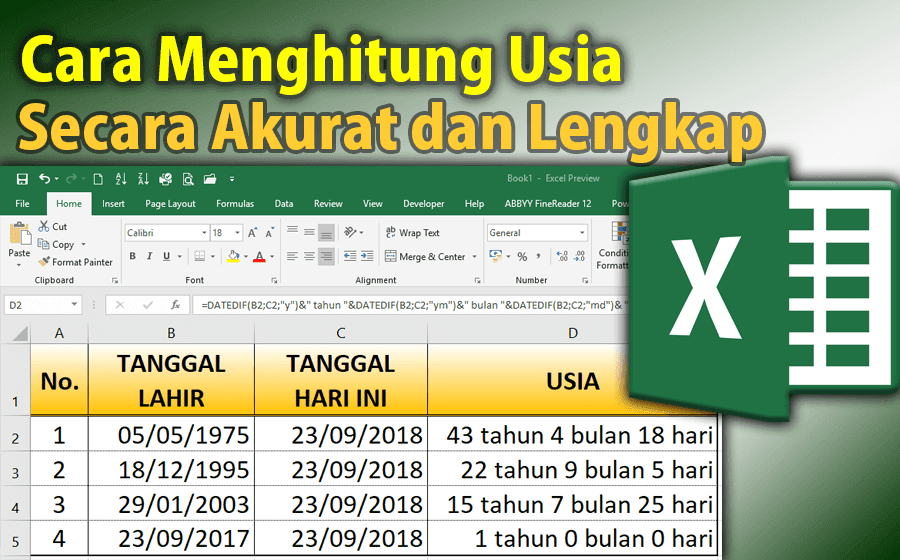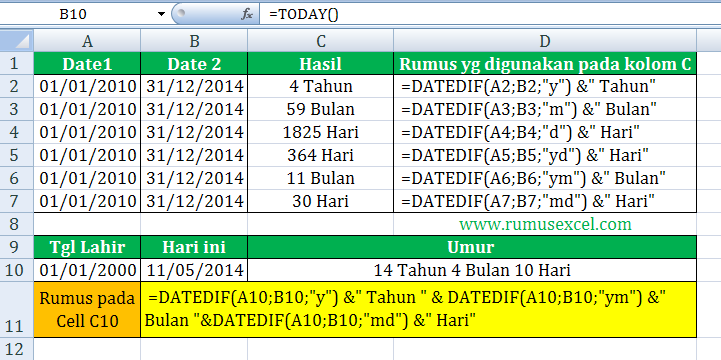Ever found yourself needing to quickly determine someone's age from their birthdate, perhaps when working with a large dataset? We've all been there, staring at a spreadsheet filled with names and birthdates, wishing for a magic button to reveal those ages. Thankfully, Excel comes to the rescue with its powerful formulas, making age calculation a breeze.
Before diving into the how-to, let's appreciate the convenience this brings. Imagine manually calculating ages for hundreds or even thousands of entries – a tedious and error-prone task! This is where Excel's age calculation function becomes invaluable. Whether you're managing employee records, analyzing demographic data, or simply organizing a guest list, this function can save you significant time and effort.
The beauty of Excel lies in its ability to simplify complex calculations. While the concept of calculating age is straightforward, doing it repeatedly for numerous entries can be cumbersome. Excel eliminates this hassle by providing a dedicated formula, eliminating manual calculation and minimizing errors.
You might wonder about the practical applications of this function. Let's consider a scenario where you're organizing a birthday party and need to send age-specific invitations. With Excel, you can easily determine the age of each guest from their birthdate and filter them into different age groups, making the invitation process efficient and accurate.
This seemingly simple function proves invaluable in various fields. Healthcare professionals utilize it for patient data analysis, marketers use it for targeted campaigns based on demographics, and educators leverage it for student record management. The applications are endless, highlighting the versatility and importance of age calculation in Excel across diverse domains.
Now, let's explore the different ways to calculate age in Excel. One commonly used function is the "DATEDIF" formula. This versatile function allows you to calculate the difference between two dates in years, months, or days. For instance, to calculate age in years, you would use the formula "=DATEDIF(birthdate,TODAY(),"y")".
Another approach is using the "YEAR" and "TODAY" functions in combination. This method involves extracting the year from the birthdate using the "YEAR" function and subtracting it from the current year obtained through the "TODAY" function. For example, the formula would be "=YEAR(TODAY())-YEAR(birthdate)".
Regardless of the method you choose, Excel provides a straightforward and efficient way to calculate age from birthdates, saving you time and ensuring accuracy in your data analysis and management.
Advantages and Disadvantages of Calculating Age in Excel
Let's delve into the pros and cons of utilizing Excel for age calculation:
| Advantages | Disadvantages |
|---|---|
|
|
Best Practices for Calculating Age in Excel
To ensure accurate and efficient age calculation, consider these best practices:
- Data Consistency: Maintain a consistent date format (e.g., MM/DD/YYYY) throughout your spreadsheet to prevent formula errors.
- Formula Validation: Double-check your formulas to ensure they reference the correct cells and use the appropriate functions.
- Error Handling: Implement error-handling techniques, such as using the "IFERROR" function, to manage potential errors in your data.
- Data Backup: Regularly back up your Excel files to prevent data loss in case of errors or accidental changes.
- Clear Documentation: Add comments or notes to your formulas to explain their purpose and make your spreadsheet easier to understand and maintain.
Frequently Asked Questions
Here are some common questions about calculating age in Excel:
- Q: What if my birthdates are in a different format?
A: Excel offers various date formatting options. You can easily convert your dates to the desired format using the "Format Cells" feature.
- Q: Can I calculate age in years and months?
A: Yes, the "DATEDIF" function allows you to specify the output unit as years, months, or even days.
- Q: My formula is returning an error. What could be wrong?
A: Common errors include incorrect cell references, typos in the formula, or inconsistencies in date formats. Carefully review your formula and data for any discrepancies.
- Q: Are there online resources available for learning more about Excel formulas?
A: Absolutely! Websites like Microsoft Support, Exceljet, and YouTube channels dedicated to Excel tutorials offer comprehensive guides and tutorials on various Excel functions.
- Q: Can I use Excel to calculate the age of events or objects, not just people?
A: Yes, the principles remain the same. As long as you have a starting date, you can use the same formulas to determine the age or duration of anything.
- Q: Is it better to use "DATEDIF" or the combination of "YEAR" and "TODAY" for age calculation?
A: Both methods achieve the same outcome. "DATEDIF" offers more flexibility in specifying output units, while the "YEAR" and "TODAY" combination might be easier to understand for beginners.
- Q: Can I automate age calculation for new entries in my spreadsheet?
A: Yes, you can create a dynamic formula that automatically calculates age for any new birthdates entered in the designated column, ensuring your data stays up-to-date without manual input.
- Q: How do I protect my formulas from accidental changes?
A: Excel allows you to lock your formulas and protect your worksheet, preventing unintended modifications to your calculations.
Tips and Tricks
Here are a few handy tips to make your age calculation in Excel even smoother:
- Use the "Fill Handle" to quickly copy your formula across multiple cells, saving time and effort when working with large datasets.
- Explore the various date and time functions available in Excel to perform more complex calculations, such as determining the time elapsed between two events or calculating age on a specific date.
- Consider using named ranges to make your formulas more readable and easier to understand. For example, instead of referencing cells like "A1" and "B1," you could name them "BirthDate" and "CurrentDate," respectively.
Mastering age calculation in Excel empowers you to unlock valuable insights from your data. Whether you're a seasoned Excel user or just starting, remember that practice makes perfect. Don't hesitate to experiment with different formulas and techniques to find the approach that best suits your needs. Happy calculating!
Beyond blooms the ultimate guide to fake flowers with stems
Finding your inner snoopy embracing bom dia snoopy quinta feira
Unlocking nfl potential a deep dive into day 2 draft picks
cari umur dengan excel - Khao Tick On
cari umur dengan excel - Khao Tick On
cari umur dengan excel - Khao Tick On
cari umur dengan excel - Khao Tick On
cari umur dengan excel - Khao Tick On
cari umur dengan excel - Khao Tick On
cari umur dengan excel - Khao Tick On
Contoh Soal Tabel Distribusi Frekuensi Dan Penyelesaiannya - Khao Tick On
cari umur dengan excel - Khao Tick On
Apakah Berat Badan Kamu Sudah Ideal? - Khao Tick On
cari umur dengan excel - Khao Tick On
cari umur dengan excel - Khao Tick On
cari umur dengan excel - Khao Tick On












